Floodwaters that devastated Central Texas in early July revealed a remarkable find: dinosaur footprints dating back 115 million years in Northwest Travis County’s Big Sandy Creek area.
The July 4 catastrophic floods, which claimed over 130 lives, including 36 children at Camp Mystic in Kerr County, uncovered the tracks by clearing away debris. Travis County Judge Andy Brown, the county’s chief executive, shared the news during an August 5 Commissioners Court meeting, noting that the Travis County Fire Marshal’s Office had marked the site.
The discovery, announced by county officials, was made over the weekend by volunteers on private property, with the exact location undisclosed at the owner’s request.
University of Texas paleontologist Matthew Brown confirmed that at least 15 footprints, each measuring 18 to 20 inches long, belong to meat-eating dinosaurs resembling the Acrocanthosaurus, a 35-foot-long bipedal carnivore. Nearby tracks may belong to a Paluxysaurus, Texas’ official state dinosaur, a large herbivorous sauropod.
The prints, embedded in the 110- to 115-million-year-old Glen Rose Formation limestone, were exposed after floods swept away sediment and debris.
“The tracks that are unambiguously dinosaurs were left by meat-eating dinosaurs similar to an Acrocanthosaurus, a roughly 35-foot-long bipedal carnivore,” Brown told CNN.
He noted that such discoveries are not uncommon in Central Texas, adding, per ABC News, “Often people don’t realize that it is possible to find them in their own backyards.”
Brown and UT Austin paleontologist Kenneth Bader visited the site to assess the tracks and advise on their protection during ongoing flood cleanup.
“We’ve been talking with the environmental monitoring company too about sensitive locations that they’ve gotten from the state and what to watch out for … basically, to make sure that they’re not rolling heavy equipment across the trackways,” Brown said, per Austin American-Statesman.
He added that his team plans to return soon to document the tracks with maps and 3D imaging to determine if multiple dinosaurs traveled together or individually.
“It’s easy to forget when you’re looking at a bone on a shelf that this was an animal that was walking around, that was interacting with other animals, that had its own life story,” Brown continued.
The discovery does not affect ongoing cleanup efforts, officials said.
Central Texas residents are encouraged to report any additional tracks to the University of Texas paleontology department. Such finds are not rare in the region, with Dinosaur Valley State Park, less than three hours north of Austin, known for well-preserved tracks, and a recent Alamosaurus fossil discovery in Big Bend National Park.


